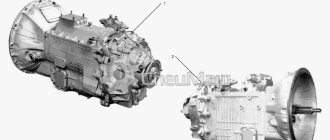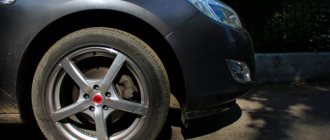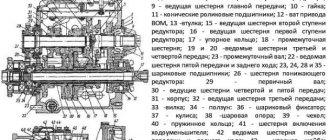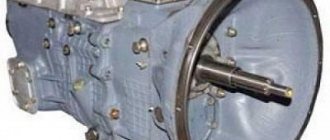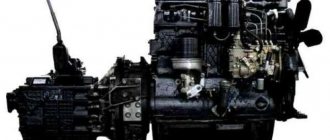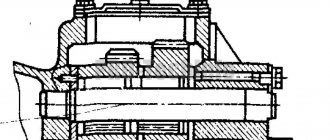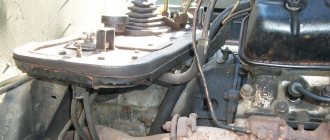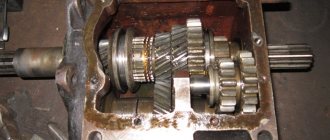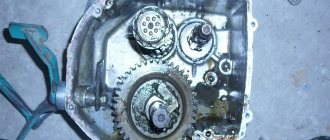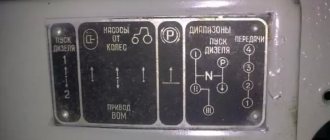| ZIL-431510 | ||
| Load capacity, kg | 6000 | 6000 |
| Curb weight, kg | 4175 | 4550 |
| Including: | ||
| to the front axle | 2005 | 2140 |
| to the rear axle | 2170 | 2410 |
| Total weight, kg | 10400 | 10775 |
| Including: | ||
| to the front axle | 2510 | 2845 |
| to the rear axle | 7890 | 7930 |
| Gross trailer weight, kg | 80001 | 80001 |
| Max. vehicle speed, km/h | 90 | 90 |
| The same, road trains | 80 | 80 |
| Vehicle acceleration time to 60 km/h, s | 37 | 37 |
| Max. climbability by car, % | 31 | 31 |
| The same, by road train | 16 | 16 |
| Vehicle run-out from 50 km/h, m | 750 | 750 |
| Car braking distance from 50 km/h, m | 25 | 25 |
| The same, road trains | 26,5 | 26,5 |
| Control fuel consumption, l/100 km, vehicle: | ||
| at 60 km/h | 25,8 | 25,8 |
| at 80 km/h | 32,2 | 32,2 |
| The same, road trains: | ||
| at 60 km/h | 33 | 33 |
| at 80 km/h | 43 | 43 |
| Turning radius, m: | ||
| on the outer wheel | 8,3 | 9,5 |
| overall | 8,9 | 10,1 |
Engine.
Maud. ZIL-508.10, petrol, V-shape. (900), 8-cyl., 100×95 mm, 6.0 l, compression ratio 7.1, operating order 1-5-4-2-6-3-7-8, power 110 kW (150 hp) s.) at 3200 rpm, torque 402 Nm (41 kgf-m), fuel pump B10 - diaphragm, K-90 carburetor with forced idle economizer or K-96, K-88AT, K-88AM, air filter - inertial oil filter VM-16 or VM-21.
Transmission.
The clutch is single-plate, with peripheral pressure springs, the release drive is mechanical. Transmission - 5-speed. with synchronizers in II, III, IV and V gears, gear. numbers: I-7.44; II-4.10; III-2.29; IV-1.47; V-1.00; ZX-7.09. Cardan transmission consists of two consecutive shafts with an intermediate support. The main gear is a single hypoid, gear. number 6.33. A drive axle with a double bevel-cylindrical main gear can be installed. number 6.32.
Wheels and tires.
Wheels - disc, rim 7.0-20, fastening with 8 studs. Tires 9.00R20 (260R508) mod. I-N142B-1 or 0-40BM-1, Installation of tires mod. I-252B or VI-244. Air pressure, kgf/cm. sq.: ZIL-431410 - tires I-N142B-1 and O-40BM-1 - front - 4.0, rear - 6.3; tires I-252B and VI-244 - front - 3.0, rear - 5.8; ZIL-431510 - tires I-N142B-1 and O-40BM-1 - front - 4.5, rear - 5.3; tires I-252B and VI-244 - front - 3.5, rear - 5.8. The number of ears is 6+1.
Suspension.
The front is on two semi-elliptic springs with rear sliding ends and shock absorbers; the rear one is on two main and two additional semi-elliptic springs, the ends of the additional springs and the rear ends of the main ones are sliding.
Brakes.
The service brake system is with drum mechanisms (diameter 420 mm, width of the front linings 70, rear linings 140 mm, cam release) with a dual-circuit pneumatic drive, with a brake force regulator. Brake chambers: front - type 16, rear - type 24/24 with spring energy accumulators. The parking brake is applied to the brakes of the rear wheels from spring energy accumulators, the drive is pneumatic. The spare brake system is combined with the parking one. The trailer brake drive is combined (two- and single-wire). Upon request, vehicles can be equipped with a brake drive without separation along the axles and with a single-line drive for trailer brakes (ZIL-130-80 vehicle brakes). There is an alcohol fuse against condensate freezing.
Steering.
The steering mechanism is a screw with a ball nut on circulating balls and a piston-rack that engages with the toothed sector of the bipod shaft, the hydraulic booster is built-in, gear number 20, oil pressure in the booster is 65-75 kgf/cm. sq.
Electrical equipment.
Voltage 12 V, ac. battery 6ST-90EM, generator 32.3701 with voltage regulator 201.3702, starter ST230-K1, ignition distributor 46.3706 with centrifugal and vacuum regulators, ignition coil B114-B, transistor switch TK102-A, spark plugs A11. Some vehicles may be equipped with a contactless ignition system.
Filling volumes and recommended operating materials.
Fuel tank - 170 l, gasoline A-76; cooling system - 26l, water or antifreeze - A40, A65; engine lubrication system - 8.5 l, all-season up to minus 30°C oil M-6/10V (DV-ASZp-10V) and M-8V, at temperatures below minus 30°C - oil ASZp-6 (M-4/ 6B); power steering - 2.75 l, all-season oil grade P; gearbox - 5.1 l, all-season oil TSp-15K, substitute - oil TAP-15V, at temperatures below minus 30°C oil TSp-10; hypoid final drive housing - 10.5 l, all-season hypoid gear oil TSp-14 gip, at temperatures below minus 30°C oil TSz-9 gip; two-stage final drive housing - 4.5 l, gearbox oil; shock absorbers - 2×0.41 l, liquid AZh-12T; windshield washer reservoir - 2.7 l, NIISS-4 liquid mixed with water; fuse against condensate freezing - 0.2 l, ethyl alcohol.
Weights of ZIL-431410 vehicle units
(in kg). Power unit assembly - 640; engine - 500; gearbox (without parking brake) - 98; cooling system radiator - 20; cardan shaft - 36; rear axle assembly with brake mechanisms - 477; front axle assembly with brake mechanisms - 243; springs: front - 37; rear - 70; additional - 25; wheel with tire - 93; frame with buffer and towing device - 430; cabin - 280; tail (facing with wings and mudguards, hood) - 70; platform - 580.
Source
Device
ZIL 130 has a fairly simple design. The front suspension is built on 2 semi-elliptic springs with shock absorbers and rear sliding ends, the rear suspension is built on 2 main and 2 additional semi-elliptic springs. These elements also received sliding ends.
The car has a rear-wheel drive axle and a dry clutch with a single disc. The ZIL 130 transmission is mechanical with one disc and a pair of synchronizers (for 2nd and 3rd, 4th and 5th gears). The 5-speed gearbox has a constant gear engagement with the exception of reverse and 1st gears. For the automotive industry of that time, this unit was considered new, but during its operation it changed several times. Torque is transmitted from the gearbox to the rear axle via a cardan shaft. For the ZIL 130 model, two shafts mounted on the frame were used. For versions with a shortened base, one shaft was used without an intermediate support. The first transmissions for the car were designed in 1961; 6 years later they underwent minor changes. In the restyled gearbox, the retaining ring was removed. The gear shift knob was insulated with a special rubber seal, which prevented moisture from entering the gearbox. The crankcase was made of high quality cast iron.
The braking system of the model consisted of drum-type brakes operating under the influence of a pneumatic system. A specialized tank with high pressure made it possible to maintain an air reserve. The parking brake used a drum that locked the driveshaft.
Electrical diagram of ZIL 130
The appearance of the ZIL 130 was very unusual for models produced in the 1960s, so the car immediately attracted the attention of others. The car received a non-military paint job for the first time. Previously, all the plant's products were khaki. Now there are modifications of white and blue colors. Streamlined fenders, an alligator-type hood and a panoramic windshield were prepared especially for the ZIL 130. Not all drivers were happy with this decision. Giving up the windshield did not happen right away. Another memorable element was the new shaped radiator grille.
PTO power take-off.
Its name hints at the fact that it takes part of the engine torque and transfers it to special mechanisms. This could be a hydraulic pump or a utility equipment attachment. The PTO works in close conjunction with the gearbox, and is activated from the vehicle cabin. A huge amount of load and work falls on this small device.
Power take-off
Therefore, they always strive to make it strong and durable. There are 2 types of PTO, clutch dependent and clutch independent. The first one works when the engine is idling. Dependent PTO is lightweight, easy to install and requires almost no maintenance. They are mounted on a manual transmission and activated by the driver from the cab. An independent PTO can work with both manual and automatic transmissions.
It is installed on concrete mixers, road cleaning equipment, and agricultural machines. The place where the PTO is registered can be a gearbox, transfer case, engine, or the space between the engine and gearbox. KOM is a highly durable unit, but even it can break.
Often, breakdowns are immediately visible; the PTO either stops turning on normally or begins to make loud noise. Problems are solved in different ways, starting with simply tightening the nuts and ending with complete disassembly of the PTO. In any case, without the appropriate knowledge and skills, independent repair of the PTO is not recommended by the manufacturer.
WATCH THE VIDEO
Gear diagram
Gear diagram
Primary shaft
Primary shaft ZIL-130
The primary shaft is made of steel 25 KhGM, the depth of the nitro-carburized layer is 0.6...0.8 mm, the hardness of the surface layer is HRCe 61...66, the hardness of the core is HRCe 37...46.
Basic data on shaft seats, permissible wear of splines, journals and shaft seats for bearings, as well as data on gears.
Thickness of straight spline teeth - 5, 805…5, 855
The diameter of the roller bearing seat is 43.980…44.007
The diameter of the shaft journal for the ball bearing is 60.003…60.023
Shaft end journal diameter - 24.975...24.995
Secondary shaft
Secondary shaft ZIL-130
The secondary shaft is made of steel 25 KhGM, nitrocarburization depth 0.8...1.1 mm, surface layer hardness HRCe 61...66, core hardness HRCe 37...46.
The runout of the secondary shaft journals relative to the axis is allowed no more than 0.05 mm. The use of necks on crumbled cemented layers of a fatigue nature is not permitted.
Parameters of the secondary shaft journal splines
The diameter of the journal of the front end of the shaft for the roller bearing is 29.939..29.960
The diameter of the journal for the ball bearing is 50.003…50.020
The diameter of the journal for the bushing of the constant mesh gear of the fourth gear is 47.003...47.020
The diameter of the journal for the second gear constant mesh helical gear is 60.920…60.940
Thickness of the tooth of the splined part of the shaft for the synchronizer:
second and third gears - 8.88...8.94
fourth and fifth gears - 10.90...10.95
The tooth thickness of the splined part of the shaft for the first gear gear is 10.88…10.94
Tooth thickness of the splined part of the shaft for the flange - 5.99...5.94
Body size ZIL-130 dump truck
- length - 6675 mm;
- front wheel track - 1800 mm;
- rear wheel track - 1790 mm;
- cabin roof height - 2400 mm;
- height along the sides of the cargo platform - 2050 mm;
- wheelbase - 3800 mm;
- tilt angle - 38 degrees;
- turning diameter - 14 m;
- curb weight - 5100 kg;
- load capacity - 9000 kg;
- total weight - 14,100 kg;
- distribution to the front axle - 4200 kg;
- distribution to the rear axle - 9900 kg.
How much does a ZIL 130 dump truck weigh for scrap metal?
Often people who have a car that has already served its purpose decide to sell it for metal. One of the frequently asked questions by such sellers is the following: “How much does a ZIL 130 dump truck for scrap metal weigh?” As a rule, a car can weigh up to 5 tons, and maybe no more than 500 kg if certain parts of it are rented out. The weight of ZIL is determined by the following factors:
- availability of all components;
- taking into account the percentage of non-metallic impurities;
- degree of vehicle pollution.
Thus, a full-fledged ZIL will weigh approximately 4.3 tons, if assembled. At the same time, when handing it over for scrap, you should be prepared that the acceptors will take away the weight of non-metallic parts, such as rubber, plastic and others, and also remove a percentage of contamination.
Thus, how much a ZIL 130 car will weigh can be found out by consulting with appraisers who weigh such types of scrap. Regardless of weight, scrapping ZIL is much more profitable and safer for the environment than throwing it in a landfill. The average cost of an assembled ZIL as scrap will be 10 thousand rubles, but the exact amount can only be found out after a preliminary inspection and weighing of the vehicle, taking into account non-metallic parts and the degree of contamination.
ZIL-130 is the first civilian dump truck of the brand, produced back in the USSR. Initially, the equipment was created for military needs. The cars were then adapted for civilian use. ZIL-130 or simply “Kolkhoznik” has become one of the most popular domestic medium-tonnage vehicles. Today, the car maintains its position in the market due to its low cost and quick payback.
Transmission and chassis
The car in question is equipped with a five-speed manual gearbox. The main gear type is hypoid.
The clutch is standard, disc, in an oil bath. There is a synchronizer that operates in all gears (including reverse), with the exception of 1st and 3rd.
The wheels are standard (6.5j×16H2) in the form of stamped discs made of high-strength metal. The alloy has a fairly high hardness, which allows the discs to withstand even extreme loads without any problems.
Considering that they are used on a truck, this is an important factor. Stamped wheels are fitted with regular tubeless tires - 227/75R16C.
The main transmission mechanism is a cardan transmission, equipped with three hinges, an intermediate support, and a sliding spline connection.
The impact on the road surface of an unloaded vehicle through tires is distributed as follows:
- front wheels – 2,300 kgf;
- rear wheels - 2,190 kgf.
The load on the road surface of a loaded truck is:
- front wheels – 2,350 kgf;
- rear wheels - 4,900 kgf.
Important! The turning radius, despite the relatively compact dimensions of the car, is 7.8 m, which makes driving the Bychk in the city not always comfortable.
The steering is equipped with a hydraulic booster, which greatly simplifies maneuvering.
History of creation
Work on the creation of the truck began in 1953 under the leadership of designer A. M. Krieger. Initially, the car was named ZIS-125, a little later ZIS-150M. The first models of cars in 1956 were equipped with a five-liter power plant with a capacity of 135 horsepower and a maximum torque of 320 N. m. It had a V-shaped arrangement of six cylinders and was equipped with a carburetor. However, this engine was unable to ensure the operation of a medium-duty truck. It lacked the power to create the desired dynamic characteristics.
The following year, the car received a unit with six cylinders, the valves of which are located in the upper part. It was superior to the previous version in power: 140 hp. With. and had a larger working volume: 5.5 liters. However, it also did not pass verification tests. The design team settled on the following option, which turned out to be final. This option was used throughout the entire production period of the truck. The six-liter engine had 150 horsepower and was equipped with liquid cooling. The model for creating this installation for a truck was the “engine” from the ZIL-111 limousine, intended for the USSR government.
The differences between this motor and the sample were in the lower compression ratio - 6.5. This led to a decrease in power - from 220 hp. With. it dropped to 148 hp. With. The class of fuel consumed has also changed. The government limousine consumed expensive gasoline with an octane rating of 95; a work vehicle could not afford such luxury. He was switched to 76 gasoline, which was popular at that time.
Two years after the launch of the series, the plant management modernized the car and engine. During its implementation, the power of ZIL with index 130 increased slightly to 150 “horses”. This value remains until the end of the machine's production period. At the same time, the service life before major repairs was regulated - 200,000 mileage. The next modernization, carried out in 1976, made it possible to increase the service life to 300 thousand km.
The new power unit with the factory index 508 had a good appetite. Its consumption per 100 km ranged from 30 to 40 liters. However, given the fuel prices of those times, such consumption was not critical. As a result, ZIL produced over three million of these units. There were legends about the unpretentiousness in operation and maintenance of this unit. It tolerated the heat of the southern republics of the USSR well; there were no problems with its launch in frosty weather in the northern regions of the country
Note that in 1974, the ZIL 130 medium-duty truck began to be equipped with a more economical engine with less power, the ZIL-157 with 110 “horses” under the hood.
At the turn of the eighties and nineties of the last century, when the political situation in the country changed radically and fuel prices soared, ZIL management made attempts to switch the popular truck to cheaper diesel fuel. But in the end they were unsuccessful. Later, in order to reduce fuel costs, truck owners began to switch to using gas-cylinder equipment.
